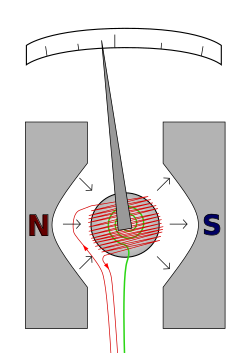Now that we are aware of the 4 terms (VOLTAGE, CURRENT, POWER, FREQUENCY) which associated with electricity, lets take a look at what all instruments we need to measure them and how they work.
If you want to measure VOLTAGE we use an instrument called VOLTMETER
If you want to measure CURRENT we use an instrument called AMMETER
If you want to measure POWER we use an instrument called WATTMETER
If you want to measure FREQUENCY we use an instrument called FREQUENCY METER
Lets now briefly take a look at how these instruments work:
VOLTMETER
 |
| Figure shows a typical Voltmeter |
The basic analog voltmeter comprises of a 'pointer' needle which is attached to a movable coil which in turn is mounted on a pivot. The pivot allows the coil to rotate, which lets the pointer swing across the meter face marked with a graduated scale., The coil is situated between two opposing polarity magnets. The coil is also spring loaded so as to keep the needle at zero when no voltage is supplied.When a voltage is applied to the coil, the coil starts to rotate against the spring. As more voltage is applied, more force is generated between the coil and the magnets causing the coil to rotate further. As the coil rotates, the needle moves across the meter face and the voltage can be read from the scale on the meter face.
 |
| Image showing working of a analog voltmeter |
AMMETER
The basic analog ammeter comprises of a 'pointer' needle which is attached to a movable coil which in turn is mounted on a pivot. The pivot allows the coil to rotate, which lets the pointer swing across the meter face marked with a graduated scale., The coil is situated between two opposing polarity magnets. The coil is also spring loaded so as to keep the needle at zero when no current is supplied.When a current is applied to the coil, the coil starts to rotate against the spring. As more current is applied, more force is generated between the coil and the magnets causing the coil to rotate further. As the coil rotates, the needle moves across the meter face and the current can be read from the scale on the meter face.
It looks exactly the same as a voltmeter?
Yes both work on the same principle and their construction is the same however the only difference between the two instruments is the way in which resistors are used, within the instruments, to make one suitable for measuring current and the other suitable for measuring voltage. Always remember that in voltmeters the current which operates the coil is proportional to the voltage appearing across the voltage.
Please note that when we measure voltage, voltmeter, it is connected in parallel to the circuit under test and when measuring current, ammeter, is connected in series to the circuit under test.
WATTMETER
 |
| Image take from tpub |
FREQUENCY METER
Every physical object (which possess the property of elasticity) has a certain inherent frequency at which it vibrates and this is called Resonant Frequency. The tuning fork is a great example of this: strike it once and it will continue to vibrate at a tone specific to its length.
Imagine a row of progressively-sized tuning forks which arranged side-by-side and are all mounted on a common base, and that base is vibrated at the frequency of the measured AC voltage (or current) by means of an electromagnet. Whichever tuning fork is closest in resonant frequency to the frequency of that vibration will tend to shake the most and can be seen shaking on the meter.
 |
| Vibrating reed frequency diagram - Image source - all about circuits |
 |
| Image showing the front view of the Vibrating reed frequency meter - Image source all about circuits |





